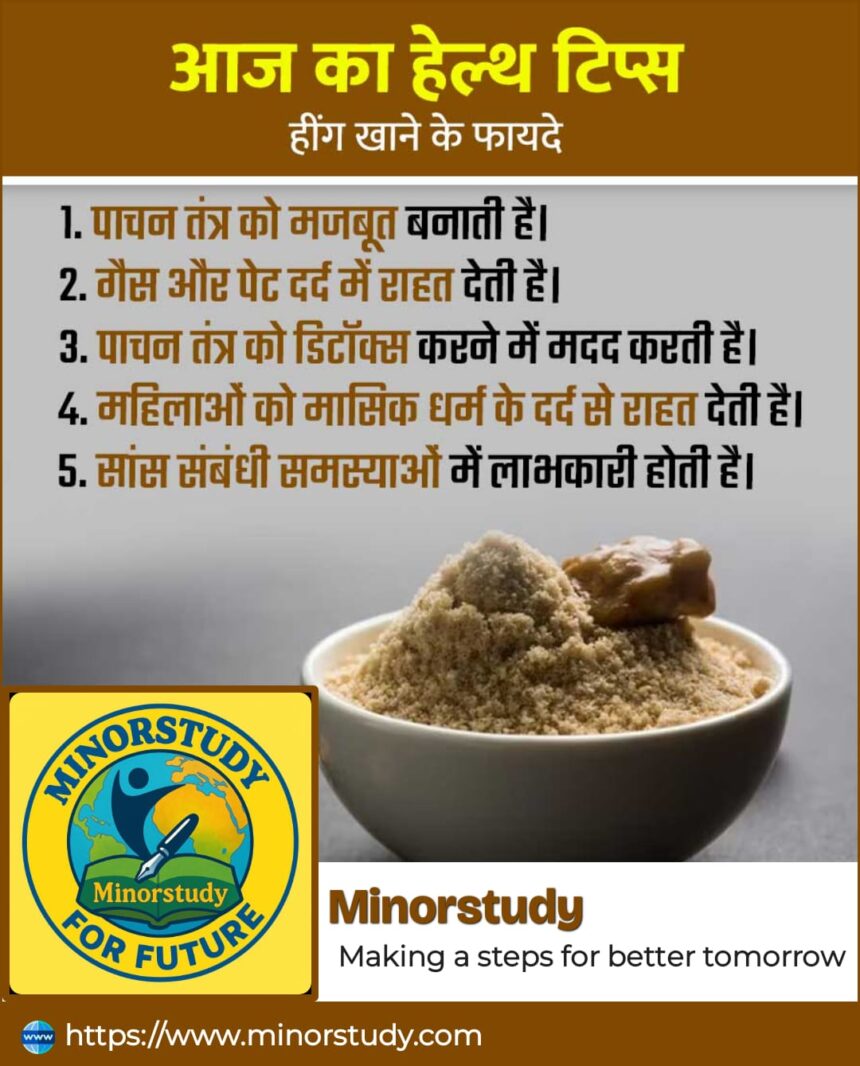🌱 7 Positive Benefits of Eating Asafoetida That Absolutely Boost Your Wellness!
Introduction: The Pungent Power of Nature
Asafoetida—known as hing in India—is a pungent resin from the Ferula plant, native to Iran, Afghanistan, and Kashmir pmc.ncbi.nlm.nih.gov+13en.wikipedia.org+13careinsurance.com+13. Despite its strong “stinking gum” smell (earning it nicknames like “devil’s dung”), when lightly fried in oil, it transforms into a mild, savory aroma reminiscent of garlic and onions allrecipes.com+4healthline.com+4hingwala.com+4.
- Introduction: The Pungent Power of Nature
- 🕰️ A Storied History of Asafoetida
- 📌 Quick Facts About Asafoetida
- 📅 Timeline of Asafoetida Through the Ages
- 🌿 7 Scientifically Proven Benefits of Eating Asafoetida
- 1. 🧠 Super Digestive Aid & Gas Buster
- 2. 💖 Rich in Antioxidants & Anti-inflammatory Agents
- 3. 🌬️ Supports Respiratory Health
- 4. 🔻 Helps Regulate Blood Pressure & Lipids
- 5. 🧬 Anti-microbial & Antiviral Defense
- 6. 🩸 Blood-thinning & Menstrual Health Support
- 7. 🧠 Neuroprotective & Cancer-fighting Potential
- 🙋 Common FAQs About Asafoetida
- 🎉 Cultural Significance, Wishing & Observance
- 📌 Key Takeaways & Daily-Life Impact
- 🌍 Importance to Society & Holistic Wellness
- 🏁 Conclusion: A Pinch of Power
In this in-depth guide (>1,200 words), we’ll explore the history, fascinating facts, timeline, cultural significance, daily-life impacts, FAQs, wishing messages, and concluding insights about this incredible spice. You’ll also learn why adding asafoetida to your diet can be a true wellness game-changer.
🕰️ A Storied History of Asafoetida
Ancient Persia & Alexandria
Originates from Ferula assa‑foetida, a wild carrot relative found in arid regions like Persia whetstonemagazine.com+3en.wikipedia.org+3es.wikipedia.org+3.
Used as a substitute for the extinct silphium gum in Greece and Rome since Alexander the Great’s time (~4th century BCE) whetstonemagazine.com+1en.wikipedia.org+1.
Valued in Mediterranean medicine and cuisine, despite its odor—Dioscorides noted Persian asafoetida as “nastier” than Cyrenaic silphium but still effective pmc.ncbi.nlm.nih.gov+5whetstonemagazine.com+5en.wikipedia.org+5.
Arrival in India & Adoption
Traded via the Silk Road, it reached India around 400 BCE aurganicum.com+1hingwala.com+1.
Indian texts like Manasollasa (12th century) and Ain-i-Akbari (16th century) mention hing in cooking and medicine hingwala.com+3whetstonemagazine.com+3aurganicum.com+3.
Adopted wholeheartedly by Jain and Brahmin communities to replace onion/garlic whetstonemagazine.com+1careinsurance.com+1.
Medieval to Modern Day
Medieval Europe used it medicinally, though the smell was divisive whetstonemagazine.com+1hingwala.com+1.
In India, it became essential in tadka (tempering) for dals, pickles, sambar, and more careinsurance.com+2en.wikipedia.org+2hingwala.com+2.
Today, its cultivation extends to Himachal Pradesh since 2020—highlighting its agricultural and health importance careinsurance.com.
📌 Quick Facts About Asafoetida
Botanical: Resin from Ferula species (Apiaceae family) allrecipes.com+8en.wikipedia.org+8healthline.com+8.
Name Origins: Called hing, hingula, hingu, perungayam, devil’s dung blog.theayurvedaexperience.com+1whetstonemagazine.com+1.
Aroma: Fierce sulfur profile when raw; mellows to umami when cooked en.wikipedia.org+6whetstonemagazine.com+6allrecipes.com+6.
Culinary Role: Mimics garlic/onion; used in savory Indian, Persian, Afghan dishes careinsurance.com.
Form: Available as resin or powder (~30% resin mixed with wheat/rice flour) aurganicum.com+6en.wikipedia.org+6healthline.com+6.
Medicinal Use: Used in Ayurveda and medieval medicine for digestion, respiratory, menstrual, and neurological conditions .
📅 Timeline of Asafoetida Through the Ages
| Era | Usage & Significance |
|---|---|
| 4th c. BCE | Alexander’s troops encounter silphium substitute whetstonemagazine.com+1en.wikipedia.org+1. |
| 1st c. CE | Mentioned by Dioscorides and Hippocrates in Mediterranean medicine . |
| 400 BCE | Reaches India, enters Ayurveda . |
| 12th c. CE | Featured in Manasollasa for cooking/medicine . |
| 16th c. CE | Cited in Ain‑i‑Akbari and Portuguese texts . |
| Medieval to 16th | European medicinal use despite odor . |
| 20th–21st c. | Modern studies confirm antioxidants, digestive, respiratory benefits . |
🌿 7 Scientifically Proven Benefits of Eating Asafoetida
1. 🧠 Super Digestive Aid & Gas Buster
Stimulates digestive enzymes, bile release, and relaxes gut spasms healthline.com.
Helps reduce bloating and gas—especially helpful with beans and lentils allrecipes.com.
Clinical trials (250 mg twice daily for 30 days) showed improved IBS symptoms .
2. 💖 Rich in Antioxidants & Anti-inflammatory Agents
Contains flavonoids, tannins, and other phenols that neutralize free radicals .
May reduce chronic inflammation, protecting against heart disease, diabetes, and cancer healthline.com.
3. 🌬️ Supports Respiratory Health
Traditionally used for bronchitis, asthma, cough, hoarseness, and whooping cough rxlist.com.
Relaxes bronchial muscles in animal studies .
4. 🔻 Helps Regulate Blood Pressure & Lipids
Has hypotensive and vasodilatory effects in animal studies .
Reduces cholesterol and triglycerides, supporting cardiovascular health .
5. 🧬 Anti-microbial & Antiviral Defense
Lab tests show effectiveness against Streptococcus, fungi, colds, and viruses .
6. 🩸 Blood-thinning & Menstrual Health Support
Contains coumarins which thin blood—be cautious with anticoagulant meds rxlist.com.
Emmenagogue properties help with delayed menstruation, cramp relief, and postpartum care .
7. 🧠 Neuroprotective & Cancer-fighting Potential
Animal-based evidence suggests memory protection and nerve regeneration healthline.com.
Early research shows anti-cancer activity in breast and liver cells .
🙋 Common FAQs About Asafoetida
Q1. How much asafoetida is safe to consume daily?
A small pinch (0.01–0.05 g) in cooking is sufficient; supplements vary (e.g., 250–500 mg capsules). Expert advice helps tailor usage.
Q2. Who shouldn’t use asafoetida?
Pregnant women, infants, those with bleeding disorders or epilepsy should avoid it—pregnancy use may induce miscarriage allrecipes.com.
Q3. Does it replace garlic and onions in vegetarian cooking?
Absolutely—hing offers that umami depth without alliums, aligning with Jain, Brahmin, and Hare Krishna diets aurganicum.com+3hingwala.com+3whetstonemagazine.com+3.
Q4. Can hing cause side effects?
Minor reactions include burping, gas, diarrhea, headaches; large doses may cause irritation .
Q5. Best storage method?
Keep in airtight container away from humidity; raw resin lasts longer than powdered blends .
🎉 Cultural Significance, Wishing & Observance
Spiritual use: In Bhagavata Purana, hing is avoided before worship careinsurance.com+2en.wikipedia.org+2aurganicum.com+2.
Symbol of wellness: In medieval Europe, hing was carried to ward off disease en.wikipedia.org.
Gifting message:
“May this humble spice bring you inner harmony, good health, and joyful digestion.”
Observed by: Jain, Brahmin, Hare Krishna, and various vegetarian communities using hing to honor non-violence while retaining flavor.
📌 Key Takeaways & Daily-Life Impact
Unique flavor: Adds a garlicky-onion depth without actual alliums—perfect for vegetarian diets.
Digestive powerhouse: Excellent when cooking beans, lentils, and cruciferous veggies.
Medicinal multipurpose: Supports gut, lungs, heart, menstrual health, and more.
Affordable and accessible: A little goes a long way—widely available in Indian groceries.
Ecological & ethical: Vegetarian-friendly, aligns with non-violence traditions.
Mindful usage: Use small amounts; check with doctors if pregnant or on medications.
🌍 Importance to Society & Holistic Wellness
Asafoetida is more than a seasoning—it’s a bridge between culinary tradition and natural health. Its journey illustrates cultural fusion and human ingenuity. In today’s focus on gut health, immunity, and reducing chemical reliance, hing shines as a simple, effective super-spice. Promoting its thoughtful use in communities encourages:
Rural cultivation efforts (e.g., Himachal Pradesh initiatives) hingwala.com+1aurganicum.com+1
Holistic education in schools and kitchens
Respect for traditional medicine and sustainable diets
🏁 Conclusion: A Pinch of Power
From ancient Persia to your everyday dal, asafoetida blends flavor and wellness in one tiny pinch. It’s not just a spice—it’s a digestive aid, respiratory support, antimicrobial, heart-smart agent with deep cultural roots.
Next time you sprinkle hing in your cooking, remember you’re tapping into centuries-old wisdom—bringing bold taste, better health, and soulful tradition into your home.








